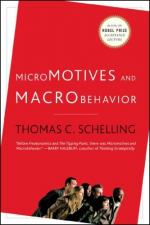
|
| Name: _________________________ | Period: ___________________ |
This quiz consists of 5 multiple choice and 5 short answer questions through Chapter 5: Sorting and Mixing: Age and Income.
Multiple Choice Questions
1. What does Schelling say the defines independent variable in a behavioral system?
(a) The imp of the perverse.
(b) The sum of the dependent variables in parallel systems.
(c) The sum of the dependent variables.
(d) The sum of the independent variables in linked systems.
2. What name does Schelling give to the effect people have on each other's behavior?
(a) Contingent behavior.
(b) Emotional intelligence.
(c) Anxiety of influence.
(d) Archetypal intelligence.
3. What example from nature does Schelling contrapose to human decisions?
(a) Photosynthesis.
(b) Instinct.
(c) Gravity.
(d) Evolution.
4. What additional reason does Schelling give for the desire to sit in the back of a theater?
(a) People want to be far from the stage.
(b) People want to be prepared to flee.
(c) People want to feel safe in the dark.
(d) People want to watch people arrive.
5. How does Schelling describe the Golden Gate Bridge?
(a) As a static equilibrium.
(b) As a closed system.
(c) As an open system.
(d) As a semi-closed system.
Short Answer Questions
1. What does Schelling say economic models of human behavior consider?
2. What does Schelling say the simplest model of a closed system with a density enhancement contains?
3. What does Schelling say you must know in order to understand what segregation might result from choice?
4. What example does Schelling use to explain the closed system with a density enhancement?
5. What does Schelling say about discrimination as a reason for segregation?
|
This section contains 308 words (approx. 2 pages at 300 words per page) |

|




